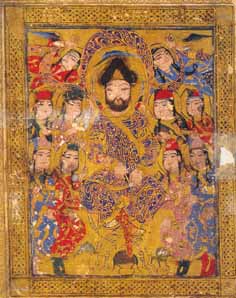Arabic poetry
| Advanced search |
- About 5 results found and you can help!
 Illustration from Kitab al-Aghani (Book of Songs), 1216-20, by Abu al-Faraj al-Isfahani, a collection of songs by famous musicians and Arab poets. |
Arabic poetry (Arabic: الشِعْر العَرَبي / ALA-LC: ash-shi‘ru al-‘Arabīyu) is the earliest form of Arabic literature. Present knowledge of poetry in Arabic dates from the 6th century, but oral poetry is believed to predate that. Arabic poetry is categorized into two main types, rhymed, or measured, and prose, with the former greatly preceding the latter. The rhymed poetry falls within fifteen different meters collected and explained by al-Farahidi in The Science of `Arud. Al-Akhfash, a student of al-Farahidi, later added one more meter to make them sixteen. The meters of the rhythmical poetry are known in Arabic as "seas" (بحور). The measuring unit of the "seas" is known as "taf`ila" (تفعيلة) with every sea containing a certain number of taf’ilas that the poet has to observe in every verse (bayt) of the poem. The measuring procedure of a poem is very rigorous. Sometimes adding or removing a consonant or a vowel can shift the bayt from one meter to another. Also, in rhymed poetry, every bayt has to end with the same rhyme (qafiya) throughout the poem.
- See also: Wikipedia
- Related: Arabic literature, Arabic music
| The canonical meters of Arabic poetry The canonical meters of Arabic poetry www.learnarabiconline.com/classical-poetry.shtml - Web |
| Princeton Online Arabic Poetry (read and listen) Princeton Online Arabic Poetry (read and listen) www.princeton.edu/~arabic/poetry/ - Web |
| Arabic poetry in arabic by era Arabic poetry in arabic by era www.al-hakawati.net/arabic/arabpers/poemindex.asp - Web |
Average relevance
| Arabic Poets Arabic Poets www.poetseers.org/the_great_poets/ar/ - Web |
| Islamic Poetry Islamic Poetry islamicpoems.blogspot.com - Web |